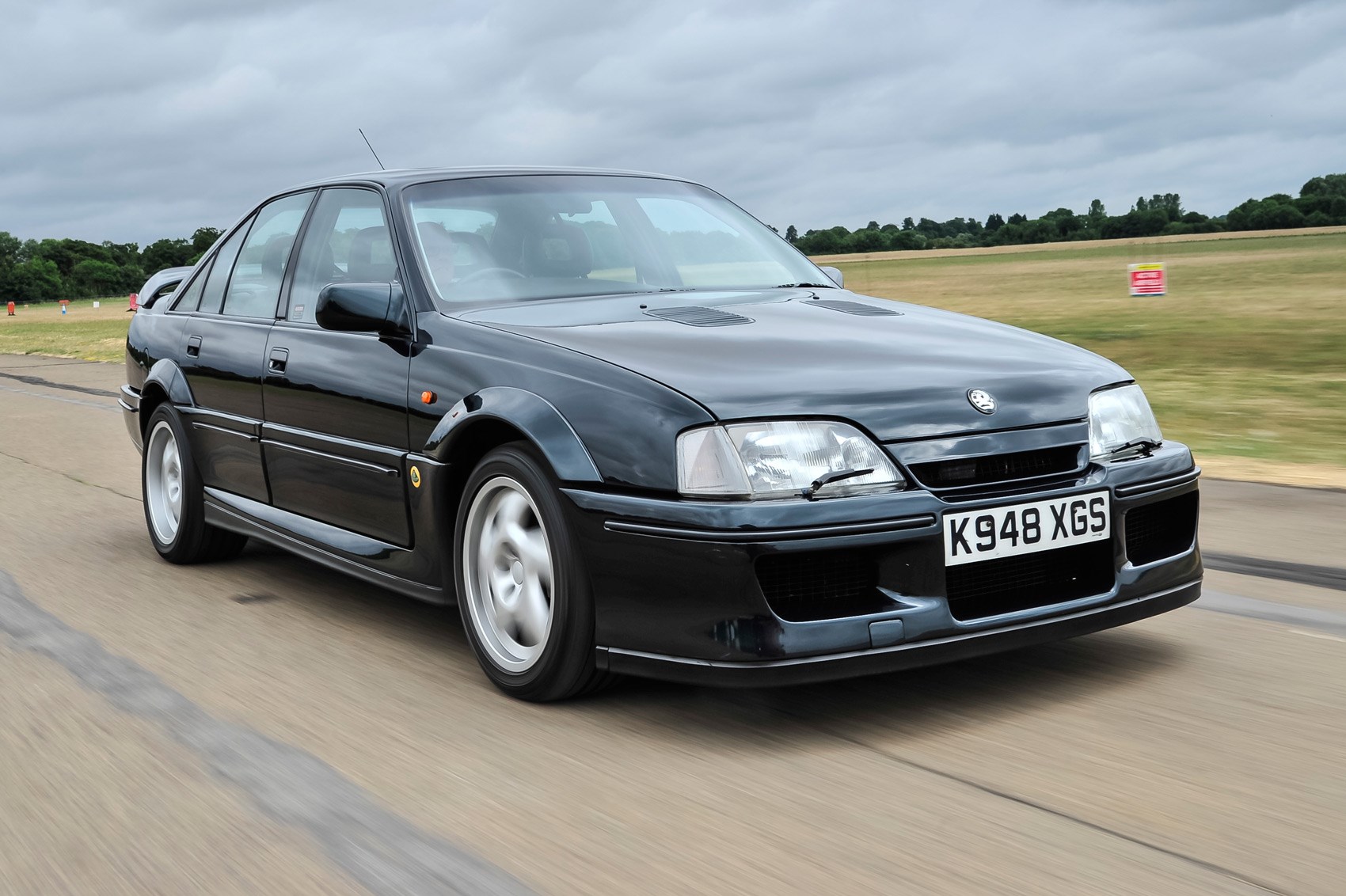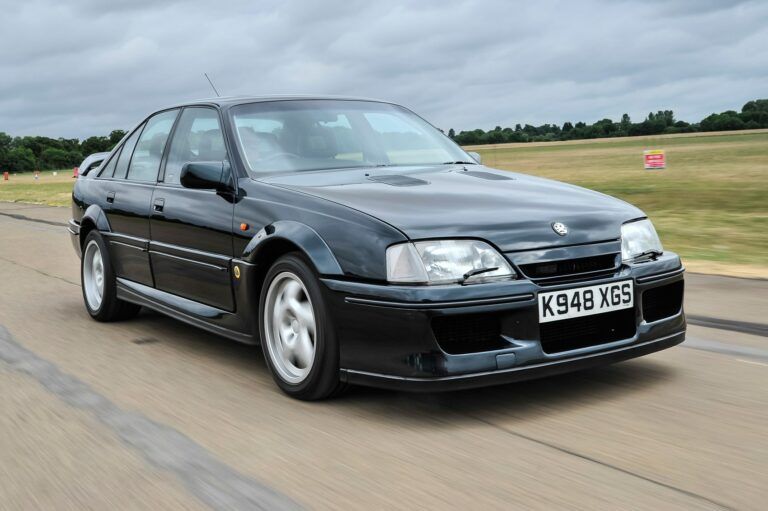
In 1990, a car that had 377hp and 419 lb-ft of torque was launched. It could do 0-60 in just 5.1 seconds (a Ferrari 348 could do 0-60 in 5.2 seconds) and flat out it could do a top speed of 176 mph (a 964 Turbo could do 168 mph). It had two turbochargers, 6-cylinders, and the brakes were 12.9-inch discs with AP-racing four-piston calipers at the front and two-piston calipers at the rear. It was a serious car but it was different.
It wasn’t a super-low sleek supercar. It didn’t have a Ferrari or Porsche badge on the back, but it did have the name Lotus on the rear. But it wasn’t an Esprit. In fact, it was based on a humble executive sedan known as the Vauxhall Carlton/Opel Omega.
The Carlton/Omega was a sensible car. It was something that the manager would drive which meant it was somewhat boring. The Carlton was made from 1986 till 1993 and the Omega was produced through two generations from 1986 till 2003 (the Carlton was re-badged Omega for the second generation).
So how on earth did one of the most uninspiring cars ever become one of the most iconic cars ever? Well, let’s find out.
Picture via: carmagazine.co.uk
The Story Of The Lotus Partnership.
Everyone knows who Lotus is. They make very good sports cars and an electric hypercar known as the Evija. They also have one of the worst reputations for reliability in automotive history. Nevertheless, back in the early 1990s, they decided to partner with GM.
Previously, Lotus had worked with Ford from 1963 till 1970, to make a very fast sedan known as the Lotus Cortina. That was a car that became very famous due to its racing pedigree. During these years, Lotus was very successful in Formula One and they later became very successful in touring car racing with Ford.
Back in 1990, the Ford Sierra Cosworth was the king of fast sedans and Ford had just launched the insanely fast RS500 model. Vauxhall was a very understated brand back in 1990. Their cars were average in every single way, and they somewhat were in Ford’s shadow when it came to fast cars. There was already one pretty fast Carlton/Omega on the market, the GSi 3000. However, it was nowhere near as quick as the Sierra Cosworth at all.
The story properly started in 1987 when Jack Smith was promoted to head of GM Europe. Lotus boss Mike Kimberly decided to pitch a top-of-the-range Senator concept that would be based on the same principles of the great Lotus Cortina. Smith loved the idea massively and that’s when things started to roll.
In order for the Lotus badge to be put on the car, everything had to be perfect. However, some reluctance did happen and Jak Smith was called to GM’s Detroit headquarters in 1988 where his career was fast-tracked. Luckily though, his role was taken by Bob Eaton who became president of GM Europe. Eaton had previously worked with Lotus before prior to GM and he was a huge fan of Lotus. He straight away got to grips with the project.
However, unbeknown to Kimberly and his team, GM Europe already had proposals for the full-sized Senator sedan. Therefore, GM Europe became very reluctant to work on the Senator project, so the focus switched to the smaller Omega/Carlton sedan.
The Carlton/Omega was a 5-series sized car, that was used by the police. It was decided that the Lotus Carlton would be focused on the 3 liter 24v GSi model which was a decently quick car. The benchmark car set at the time though was not a Sierra RS Cosworth. It was the BMW M5, which at the time was one of the fastest cars in the world. It had 315hp and 266 lb-ft of torque.
Lotus didn’t just want to match the M5 on performance figures. They wanted to smash them. In fact, Lotus ended up making a sedan that smashed supercars when it came to performance figures. GM supplied the gearbox from the ZR-1 Corvette, the rear differential from the Holden Commodore V8, self-leveling rear suspension from the Senator, and of course the engine.
Lotus fitted two twin Garret T25 turbochargers, AP racing brakes, a wide body kit, 17-inch Ronal alloy wheels, an intercooler, and Goodyear Eagle tires. It was a serious bit of kit, and it ended up being a lot faster than anyone could’ve imagined.
Fully completed RHD and LHD Vauxhall Carlton’s and Opel Omega GSi models were shipped from the Opel factory in Russelheim Germany to Lotus’ factory in Hethel. Things were not very efficient at all, but nevertheless, it worked. Cars were built in factory three, and things were hard. Lotus had to strip the already built GSi models, and fitting the arches was the worst bit.
Porsche had recently worked with Mercedes to build the E500 and they had made special measures to ensure that things were efficient. GM on the other hand expected Lotus to laser cut the rear of the GSi models and weld wider arches onto the rear. The same thing happened with the transmission tunnel where that too had to be plasma-cut and welded, etc. The whole car took 130 man-hours to build and just 950 cars were built over two years from 1990 till 1992. Only 286 Carlton badged cars were made whilst the rest were Omega models. Brand new this car cost £48,000, and today a mint car will command prices of over £100,000.
The Lotus Carlton/Omega was produced in one color which was Imperial green.
The Government and Media Hated This Car.
Usually, the British Houses of Parliament debate matters such as finance, the environment, the legal system, etc. However, in 1990 they decided to debate about the speed of a certain car known in the UK as the Lotus Carlton. How could it be that a sedan car costing £48,000 be faster than a supercar? Most German manufacturers were limiting their cars to a somewhat sensible 155 mph, but Opel or Vauxhall didn’t with the Lotus Omega. The advertising for the car was also condemned by the parliament.
Then came the story of 40 RA. In a nutshell, a Lotus Carlton was stolen in the West Midlands and used as a getaway car to do a few burglaries in which it actually outran the police and the police helicopter. The police gave up on chasing this car since it was realistically, impossible. The culprits got away with stealing £20,000 worth of cigarettes and alcohol. That car ended up being abandoned in a canal, but the plate still remains on a Lotus Carlton, since the owner of that stolen car has recently purchased another Lotus Carlton.
The tabloid Daily Mail and the Association of Cheif Police Officers campaigned to ban this car since it was just too fast. Although it did gain traction, it ultimately failed. Even Autocar criticized the speed of this car and they’re a car magazine.
Just like the Sierra Cosworth, the Lotus Carlton was a frequent target for joyriders and thieves. The locks on this car were terrible, and it would take just a few minutes to break in and steal it. The police couldn’t catch it either as it was just way too fast.
It was an Autobahn killer. It was faster than anything else out there which makes it such a legendary car. The acceleration wasn’t brutal like a Cosworth Sierra, but the torque was immense and between 60 to 120 mph the car would fly.
Why You Should Buy One.
There has never ever been a car like the Lotus Omega/Carlton. No other car has had such negative media reception for being so fast. Lotus hasn’t made a car like this since and neither has GM. Hence why it is just so sought after.
You can import an Omega/Carlton into the US now as it is thirty years old. There are a few imports in the US but they are very rare. This car would never be sold in the US, even as a Chevy as it is just too fast. You can pick one up nowadays for as little as £40,000 but that will be a bit of a banger.
A properly mint car will set you back as little as £70,000 which is sports car money. However, this is a car that can still outrun most sports cars nowadays with ease. Concours cars with low miles will be over £100,000 to £150,000 which is supercar money, but this does prove just how sought-after this car is.
This is a car that will only go up in value. Parts can be somewhat easy to get hold of as it is essentially a Carlton/Omega. The interior is pretty much the same as a normal Carlton/Omega which is a bit of a shame since it is very dull. The most expensive parts for this car include bodywork, engine work, gearbox, and brakes.
However, the Lotus Carlton/Omega is such a fun car and you need to own one. It’s just so fast and so comfortable. The rear suspension would level itself at high speeds to increase stability and comfort.

